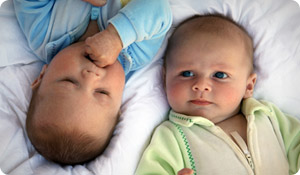
In the U.S. the rate of twin births increased by 70 percent between 1980 and 2004 and the rate of higher-order multiples (triplets or more) increased four-fold between 1980 and 1998. More recent statistics indicate the rapid rise may be slowing.
Deborah Ann Mulligan, MD is the director of the Institute for Child Health Policy and a professor of pediatrics at the Nova Southeastern University in Florida. Her four tips are:
1. Look out for yourself, first.
Moms who are healthy and happy are better positioned to care for their babies. According to the study Multiple Births Are a Risk Factor for Postpartum Maternal Depressive Symptoms mothers of multiples are 43 percent more likely than mothers of single babies to suffer moderate to severe depression nine months after giving birth. The unique demands of caring for multiples, especially fatigue and social isolation, contribute to parental stress and depression. If you feel depressed, seek medical support immediately.
2. Know that multiples are more likely to be born premature.
Babies born before 37 weeks gestation are considered premature. According to the March of Dimes Foundation, about 60 percent of twins, more than 90 percent of triplets, and virtually all quadruplets and higher-order multiples are born premature. The length of pregnancy decreases with each additional baby. On average:
- most singleton pregnancies last 39 weeks
- most twin pregnancies last 35 weeks and
- triplet pregnancies are typically 32 weeks long
Premature infants (or preemies) are not as fully developed as full-term babies and are more likely to be born with low birth weight. These factors put twins and multiples at increased risk for certain health problems including lower respiratory tract illnesses, such as Respiratory Syncytial Virus (RSV), cerebral palsy, blindness or deafness. Low birth weight has been linked to heart disease in adulthood and there is also growing evidence linking very premature birth (between 29 and 34 weeks) to autism.
3. Expect twins to share everything-including germs.
"A twin bond is special, and most twins share everything&emdash;including germs," says Dr. Mulligan. "When you have a sick twin, chances are high that the other baby will also catch the illness, especially if they are sharing the same crib."
To help minimize the possibility of sickness, the expert recommends separating the twins if one develops a contagious infection.
4. Do what you can to pevent exposure to RSV.
RSV is a virus that usually causes minor cold-like symptoms, but for some babies (especially those born prematurely) the infection can be more dangerous. "Infants who get RSV may develop apnea (breathing pauses lasting more than 15 seconds), bronchiolitis (an infection of the small breathing tubes of the lungs), as well as long-term lung problems," explains Dr. Mulligan.
RSV outbreaks usually occur between October and May. It's extremely contagious but there are important steps you can take to prevent exposure. Dr. Mulligan recommends:
- Don't allow visitors with colds or other infections to visit your new babies.
- Practice good hygiene. Have everyone wash their hands before touching your babies.
- Do not bring babies into crowded areas like shopping malls.
- Keep babies away from tobacco smoke, which increases the risk of and complications from severe RSV infections.
- Immunize all high-risk infants and their caregivers against influenza beginning at 6 months.
In spite of their often delicate start, recent medicinal advances continue to help parents keep their babies healthy and more and more preemie multiples are surviving to live long, healthy lives.
Sources:
Interview with Deborah Ann Mulligan, MD FAAP FACEP
Institute for Child Health Policy, Director
Professor Pediatrics, COM; Nova Southeastern University
American Academy of Pediatrics, Executive Council on Communications & Media, Chair
The Preemie Survival Foundation
www.preemiesurvival.org
The National Center for Vital Health Statistics
www.cdc.gov/nchs/nvss.htm
American Academy of Pediatrics
www.aap.org





